
Navigating the Global Economy
Learning
Objective
The student will demonstrate knowledge of the
global economy by explaining that when parties trade voluntarily, all benefit, distinguishing
between trade deficit and trade surplus, describing the costs and benefits of
trade barriers, and explaining growing economic interdependence.
Resources are not evenly distributed among nations, and some countries can produce certain goods and services more efficiently than others. When countries engage in voluntary trade, both parties’ benefit. Voluntary trade means that countries trade willingly and without coercion, leading to resource optimization and expanded consumer choices at lower prices.

For example, Canada efficiently produces oil, which it exports to the United States, benefiting American consumers with lower gas prices. Conversely, the United States excels in vehicle production, exporting cars to Canada, leading to lower vehicle prices for Canadians. In such exchanges, both nations reap the rewards of international trade.
Absolute and Comparative Advantage
In international trade, understanding absolute
and comparative advantage is crucial. Absolute advantage arises when a nation,
business, or individual can produce a good or service using fewer resources
than others. Comparative advantage, on the other hand, emerges when a nation,
business, or individual can produce a good or service with a lower opportunity
cost compared to its trading partners.

To clarify these concepts, consider an analogy:
imagine an athlete who excels in both tennis and personal training. While the
athlete has an absolute advantage in both areas, focusing solely on one
profession, in this case, tennis, proves more beneficial due to lower
opportunity costs. The same principle applies in international trade.
Specialization
Comparative advantage is the driving force
behind international trade as it allows countries to specialize in producing
goods and services where they excel. This specialization increases overall
global production and consumption. Rather than attempting to produce everything
themselves, nations, businesses, and individuals focus on their comparative
advantages. These specialized goods and services are either exported for profit
or exchanged for products that cannot be produced profitably, leading to
economic growth.
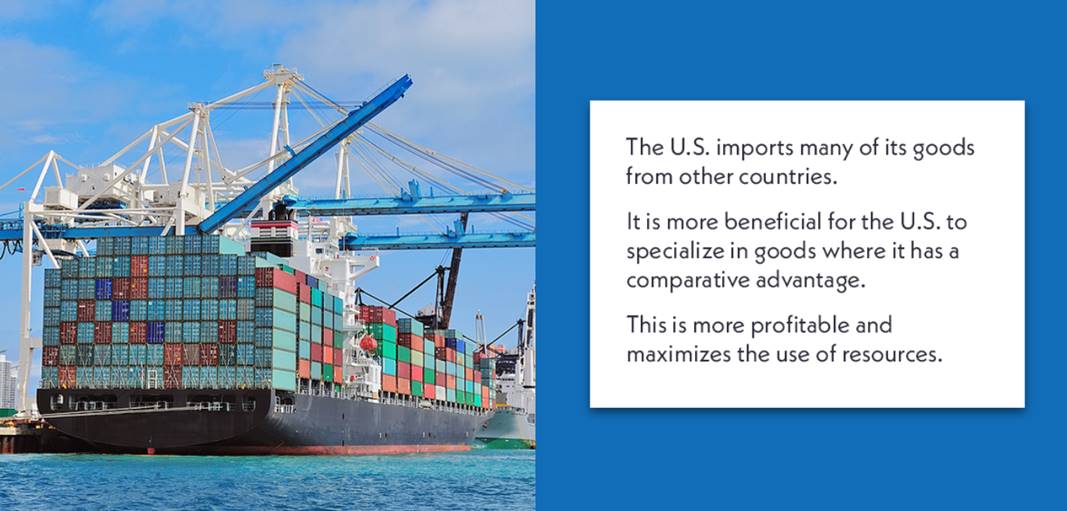
For instance, although American companies have
the capability to produce a wide array of products, the United States imports
many goods, opting to specialize in areas where it holds a comparative
advantage, maximizing resource utilization and profitability.
Scenario: Computers and Chips
To illustrate comparative advantage, consider a
hypothetical scenario. Suppose a U.S. company produces both computers and
microprocessors (chips). Making one computer requires the same resources as
producing eight chips. In contrast, a Chinese company, trading with the U.S.,
can make one computer for the cost of two chips. This means that the American
company has a comparative advantage in chip production, while the Chinese
company excels in computer manufacturing.

Let's insert hypothetical numbers to
demonstrate how each country can maximize resource utilization. Assuming both
companies have equal resources, if the American company specializes in computer
production, it can create 10,000 computers, while the Chinese company, focusing
on chip production, can produce 20,000 chips. This specialization results in
higher production and lower opportunity costs.
Applying this concept globally, the world
experiences maximum production when nations specialize in producing goods they
can make most efficiently.
Balance of Trade
The balance of trade measures the difference
between a country's exports and imports and can be either positive (surplus) or
negative (deficit). A trade surplus occurs when a country exports more than it
imports, resulting in money flowing into the nation. This can enhance a
country's standard of living. Conversely, a trade deficit happens when a
country imports more than it exports, leading to money outflow and potentially
lowering the standard of living.

Balance of Trade as an Economic Indicator
The balance of trade serves as an indicator of
a nation's economic health, tracking whether a country is spending more than it
earns or saving more than it spends. Like a personal budget, a surplus is
generally preferable, but some debt can be beneficial if used to invest in
economic growth. Economists analyze this data to gauge trends in international
trade, even though there's ongoing debate on how much deficit is harmful for a
country. Nonetheless, monitoring the balance of trade is crucial for
understanding economic trends and implications.
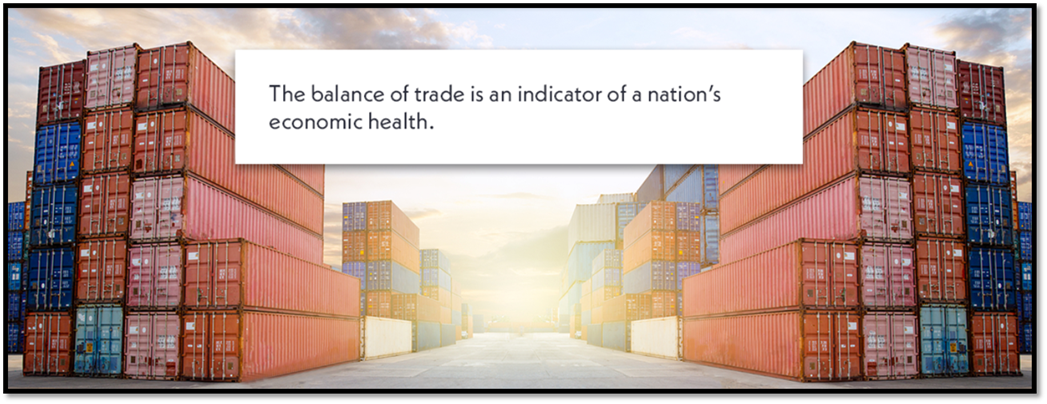
Interactivity
International trade is the process of importing
and exporting goods and services on a global scale. In this interactivity, you
will examine why nations are motivated to trade with each other. You will also
learn about the benefits of trading and the consequences of not participating
in international trade.
Barriers
to Trade
International trade offers mutual benefits to
nations, fostering economic growth and prosperity. However, various countries
erect barriers to trade for diverse reasons. Trade barriers can serve to shield
domestic industries and workers, exert diplomatic pressure, uphold certain
values, or fortify national defense.
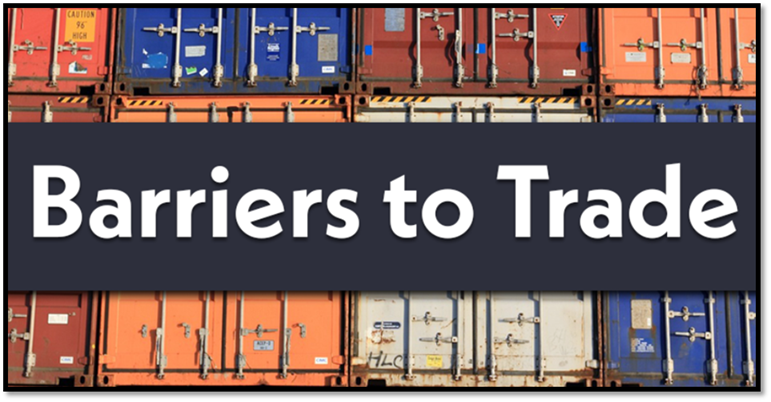
Types of
Trade Barriers
1.
Tariffs
a.
A tariff represents a
tax or duty imposed on imported goods. There are two primary types of tariffs:
revenue tariffs and protective tariffs. Revenue tariffs aim to generate
government revenue, while protective tariffs aim to safeguard domestic
businesses by restricting imports. For instance, when the U.S. imposes a
protective tariff on sugar imports, it raises the cost of foreign sugar above
domestically produced sugar, benefiting American sugar manufacturers and their
workforce.
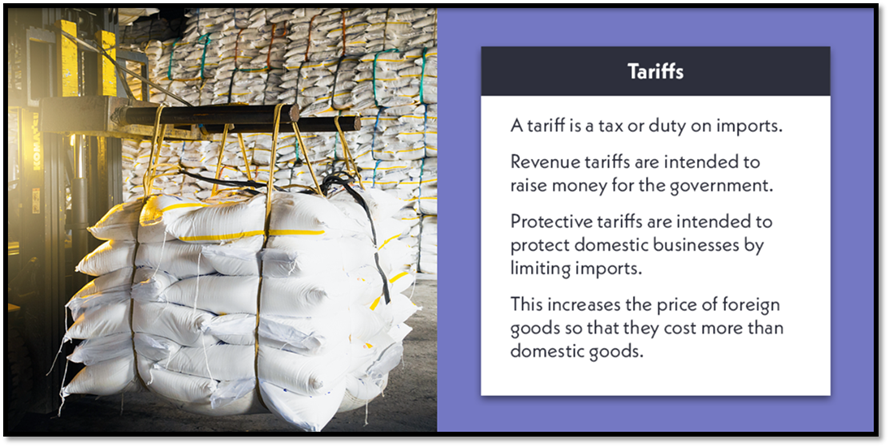
2.
Quotas
a. A quota imposes limits on the quantity of a particular good that can be imported from a specific country. Quotas are often directed at specific goods from particular nations to shield domestic industries. For example, if the U.S. sets an annual quota of 500,000 metric tons of steel from China, imports beyond this limit are prohibited. This limits competition and raises prices, favoring American steel manufacturers and their employees.

3.
Embargos
a. Embargos involve policies that restrict trade with a specific country or particular goods. These measures are typically used for political reasons, isolating nations by severing international trade connections. For instance, following the Cuban Revolution, the U.S. imposed an embargo on Cuba, prohibiting American exports to and imports from the country. Embargos can also be employed to champion certain values, such as bans on ivory to protect endangered elephants.

4.
Informal Trade Barriers
a.
Informal trade barriers
encompass policies or practices that indirectly hinder trade. Consider the
scenario where Brazilian coffee farmers employ a pesticide banned in the United
States. While the pesticide ban primarily serves environmental and consumer protection
purposes, it inadvertently reduces Brazil's coffee exports to the U.S.,
impacting coffee supply and pricing. Other examples of informal trade barriers
include health and safety regulations, licensing requirements, and child labor
laws.
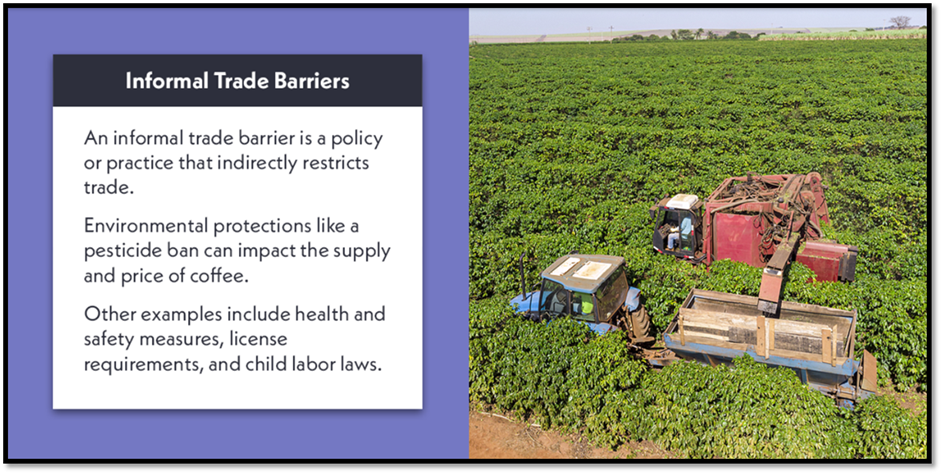
Evaluating
Trade Barriers
Trade barriers are a subject of ongoing debate
in American politics. After reviewing the various types of trade barriers, it's
essential to assess their associated costs and benefits.
·
Proponents of trade barriers argue that they shield domestic
industries and workers in protected sectors. These barriers reduce competition
and limit supply, enabling businesses to charge higher prices, thus boosting
profits. Workers in these industries may enjoy job security and elevated wages.
However, it's worth noting that the substantial financial gains from trade
barriers typically benefit only a select few with political influence, leading
to limited support for such policies.
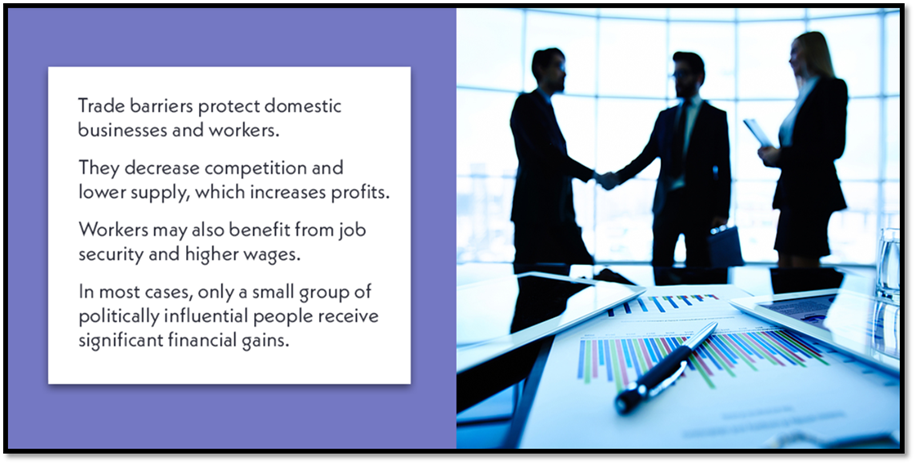
·
Opponents of trade barriers highlight the adverse impact on
consumers, who bear the brunt of increased prices for protected goods. This
cost is distributed across the entire population, often without full
comprehension of the price hike's cause. Additionally, trade barriers harm
foreign businesses and domestic importers, adversely affecting the
transportation of foreign goods.
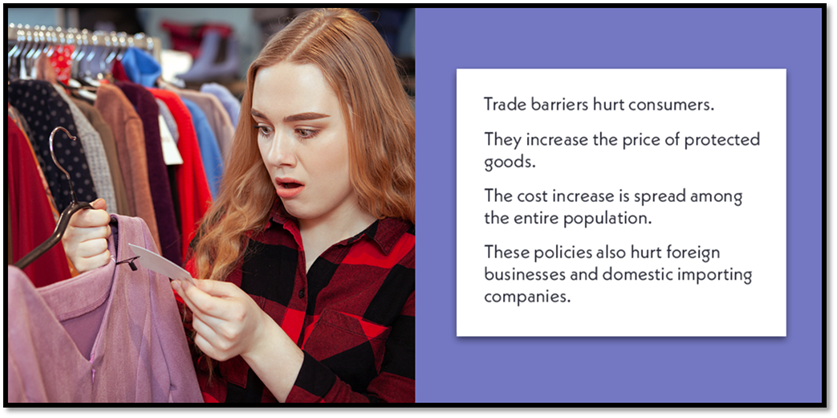
Trade barriers may also provoke trade
conflicts. For instance, if the U.S. imposes strict quotas or tariffs on
Canadian goods, Canada may respond with its own trade restrictions, potentially
escalating tensions. Such actions can harm consumers, workers, and businesses
in both countries, as well as reducing overall exports and revenue.
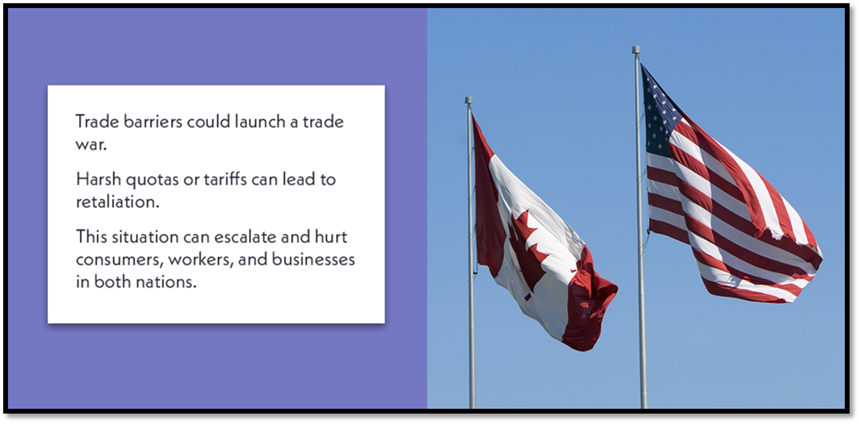
In conclusion, trade barriers are a complex
topic with diverse consequences. Understanding the trade-offs involved is
essential for informed discussions and decision-making in the realm of
international trade.
Interactivity
In this interactivity, you will learn about different trade barriers, their use, and their effect on the economy.
Economic
Interdependence and Globalization
Economic interdependence is a fundamental
aspect of globalization, deepening the ties between producers, consumers, and
financial systems worldwide.

The
Spread of Free Markets
The expansion of free markets has fostered
greater economic interdependence across the globe. In free market economies,
international trade with minimal or no trade barriers is pivotal. As these
economies expand, they create new global bonds, becoming integral parts of the
world economy as both producers and consumers. For instance, American consumers
opt for foreign goods when they are of better quality or more cost-effective,
affecting the demand for U.S. products and services and the livelihoods of
those who produce them. Similarly, since the dissolution of the Soviet Union,
Russia has broadened its trade partnerships, establishing stronger connections
with foreign markets.
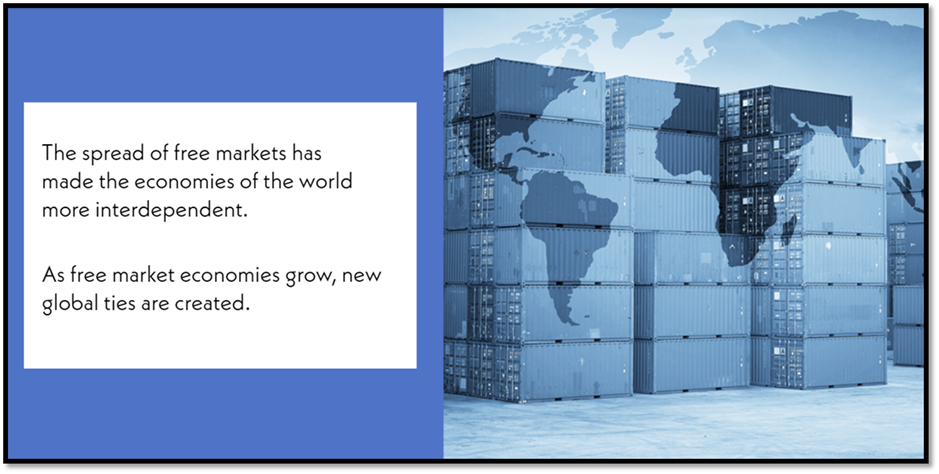
Transportation
and Communication
Advancements in transportation and
communication technologies have diminished the physical distances between
nations, benefiting global society as a whole. The communication revolution,
facilitated by satellites and computers, has accelerated the pace of globalization.
These technologies grant individuals greater access to
information about product availability and pricing in foreign nations.
Investors now have rapid access to up-to-date information, enabling them to
make informed decisions in financial markets.
These technological innovations also provide
substantial benefits to local farmers. For example, small-scale farmers in
India receive daily text messages informing them of tomato prices in local and
global markets. In the past, they would have been unaware of these prices or
learned about them much later. This instant access to information empowers
farmers to make better decisions and ultimately increases their profits.

Interconnected
Financial Markets
Globalization has fostered tighter connections
in international financial markets. Banks and investors can swiftly transfer
capital between countries in pursuit of profit, resulting in both positive and
negative consequences. On a positive note, when the stock market in a foreign
nation thrives, it attracts external investors, contributing to economic
growth. Conversely, adverse news in one country can swiftly ripple through
others. For instance, in September 2008, American bank stocks and other
companies experienced losses, prompting many investors to sell their holdings.
This precipitated a downward spiral in stock prices. Concerned investors
worldwide followed suit, triggering similar declines in European and Asian
stock exchanges. Financial markets, being highly sensitive to negative news,
can quickly impact global markets.
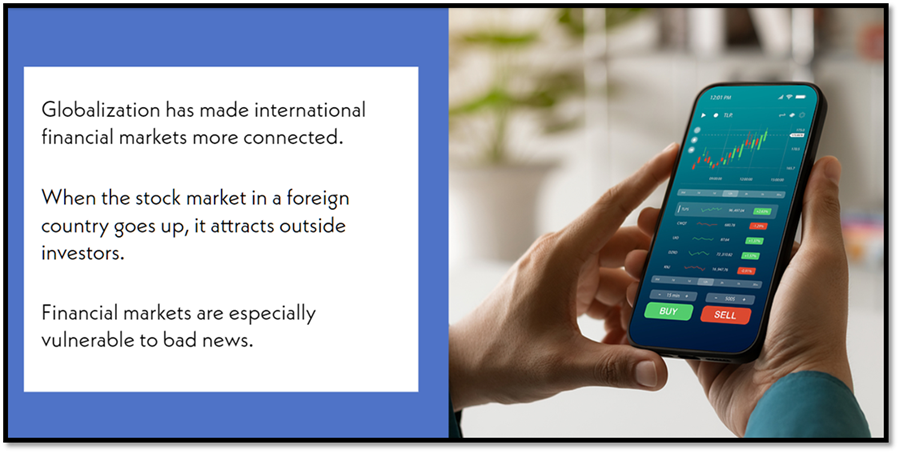
Multinational
Corporations
The growth of multinational corporations has
heightened global interdependence. Multinational corporations operate across
multiple countries. For instance, Apple designs its products in California and
manufactures most of them in China. These businesses function globally,
maintaining competitiveness, increasing profitability, and accessing diverse
resources.
Multinational corporations also introduce new
technologies, create jobs, offer training opportunities, and contribute to the
development of labor forces in the countries where they operate. However, a
significant drawback for less developed nations is that corporate profits often
flow to headquarters located in industrialized countries like the United States
or Germany. Additionally, wages in less developed countries are typically lower
than in the United States, leading to concerns that multinational companies are
displacing American jobs by establishing factories abroad.
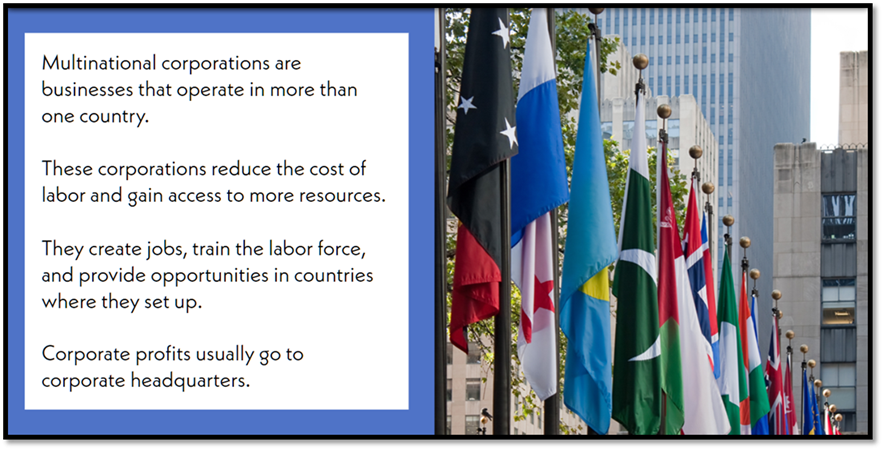
Foreign
Exchange Markets
Foreign markets and trade agreements play
pivotal roles in spreading globalization. The foreign exchange market is
essential for facilitating the flow of money between countries and global
businesses. As more nations engage in this market, conducting international
business becomes more accessible, further intertwining economies with foreign
markets. Trade agreements bolster trade among member nations, strengthening the
bonds between economies and foreign markets.
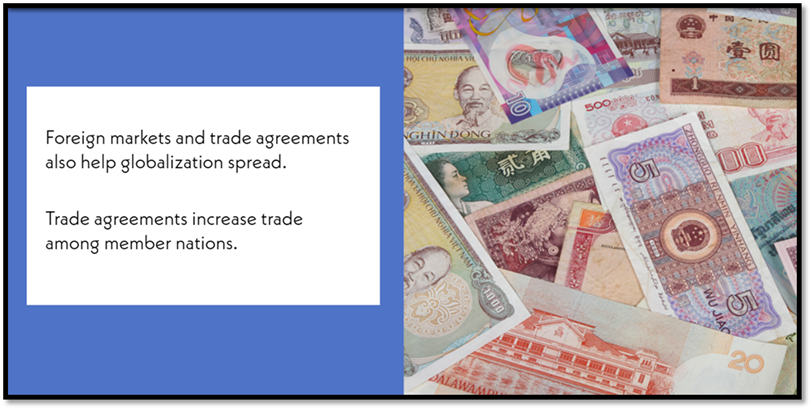
Offshoring
and Outsourcing
To cut costs, businesses in the United States
sometimes turn to foreign resources, even if it impacts the national labor
market. This practice is accomplished through offshoring and outsourcing.
Offshoring involves relocating production to another country, while outsourcing
entails assigning work to laborers in foreign countries, often via the
Internet. These strategies, driven by the lower cost of natural or human
resources abroad, can have implications for the domestic labor market and
global economic interdependence.

Interactivity
Economic interdependence falls under the
umbrella of globalization. It increases the interconnection between producers,
consumers, and financial systems worldwide. In this interactivity, you will
examine some reasons globalization has increased.